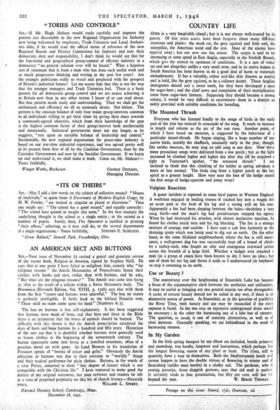AN AMERICAN SECT AND BUTTONS
SIR,—Your issue of November 23 carried a genial and generous review of my recent book, Religion in America, signed by Stephen Neill. He says that at one point I have failed to enlighten him, namely why "for religious reasons" the Amish Mennonites of Pennsylvania fasten 'their clothes with hooks and eyes, rather than with buttons, and he asks, "But what are the religious reasons?" The Amish sect came into being in 1620 as the result of a schism within a Swiss Mennonite body. The Britannica (Eleventh Edition, Vol. XVIII, p. 132b) says that with them from the first "razors and buttons were unlawful." The ban on razors is perfectly intelligible. It harks back to the biblical Nazarite vow, "There shall no razor come upon his head" (Numbers 6:5).
The ban on buttons is less self-explanatory. It has been suggested that buttons were made of bone, and that here and there in the Bible there is an intimation that the bones of animals should be burned. The difficulty with this theory is that the Amish proscription antedated the days of horn and bone buttons by a hundred and fifty years. Historians of the sect say that it is doubtful whether buttons were generally used to fasten clothes at the beginning of the seventeenth century. The button apparently came into being as a jewelled ornament, often of a precious metal set with gems. • So Lord Elerners in his translation of Froissart speaks of " botons of syluer and gylte." Obviously the Amish objection to buttons was due to their aversion to "worldly" things and their studied preference for plain clothes. Buttons, in the words of a later Pietist, connoted to them "that degree of -luxury which is not compatible with the Christian life." I have ventured to make good the defects of my original statement, lest your reviewer and readers be left in a state of perpetual perplexity on this bit of church history.—Sincerely
yours, Watatu) L. SPERRY. • Harvard Divinity School, Cambridge, Mass. December 28, 1945.


























 Previous page
Previous page